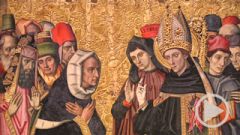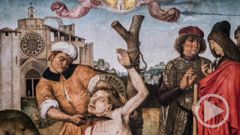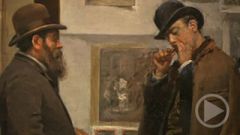The Romanesque Age
The Romanesque Age
The Vall de Boí – a small valley in the Pyrenees. At the start of the High Middle Ages most of the Iberian Peninsula was under Muslim rule. But the long arm of the Emirs did not reach the remote valleys of the Pyrenees. They were ruled by barons – nominally subordinate to the Frankish kings – but relatively unconcerned about that. The small principalities between the Empires of the Moors and of the Franks were to become the nucleus of Catalonia.
The valley of Boí was controlled by the Counts of Erill. In the early 12th century they gave military aid to the king and received royal rewards. They used the money for the glory of God – and wrote European art history here in the Pyrenees in the Middle Ages. The villages may be dwarfed by the shadows of the high peaks, but they were not cut off from the world. Wandering monks, pilgrims and traders crossed the mountains. The people of the valleys were well informed about the rest of Europe.
In the middle of the valley is the village of Boí – in the middle of the village is the parish church of San Joan de Boi – built and painted around 1100. Its murals are among the loveliest paintings of Catalan Romanesque art.
The Romanesque – this is the time of the High Middle Ages. All of Europe is under the spell of the Christian church. People’s lives are drenched in religion. Every person has their firm place in the world. The social order is God-given; no one seriously questions it. The church plays an essential role – only it is responsible for people’s salvation. Ordinary people can't read – and even if they could, they wouldn't understand the Biblical texts, for the language of the church is Latin. So pictures explain the Biblical stories and laws.
Today the works on the walls of the church are copies. The originals are kept in the museum. They include the stoning of St. Stephen, the first Christian martyr. Perhaps these minstrels and jugglers are singing psalms in praise of God? A menagerie of fabulous creatures warns the pious of the imminent Apocalypse and Judgment Day.

Frescos from more than 20 Romanesque churches can now be admired in the Museu Nacional. They show how much Catalonia was a part of European culture during the Middle Ages. Similar pictures can be found in Central France. It is likely that the motifs were spread via the Way of St. James leading to Santiago de Compostela, a major place of pilgrimage in the Middle Ages.
The Pedret Circle
In several of the churches on the edge of the Pyrenees are frescos that resemble each other so much that they are thought to be by the same painter. His masterpiece comes from the hamlet of Pedret. Today it is deserted – only the tiny church of Sant Quirze is still standing.
The images in the right hand apse depict the Wise and Foolish Virgins. The parable from the Gospel of Matthew tells of ten virgins on the way to a marriage. Before the celebration begins night falls. Five of the virgins have brought extra oil for their lamps. They are depicted at the wedding feast, wearing crowns, the symbol of eternal life. Opposite them are the foolish virgins who didn't keep their lamps lit and who missed the feast. The message is clear: only those who are prepared will be with the Lord on Judgment Day.
As is usual for medieval works of art, we do not know who painted them. But their style is reminiscent of paintings in Lombardy, so that some believe the painter came from Italy. In any case the ‘Master of Pedret’ is one of the major artists of the Catalan Romanesque. His pictures are so characteristic that today an entire group of frescos are known as the ‘Pedret Circle’.
Among them are the images from the church of Santa Maria in Àneu. Its apse can be viewed in the Museum today. It was once the most sacred part of the church – as shown by the two majestic seraphim with six wings who proclaim,“sanctus, sanctus, sanctus” – ‘holy holy holy’. Their wings are covered with eyes – as if to say ‘God sees everything’. With glowing tongs they are purifying the lips of the prophets Isaiah and Ezekiel – so that they will only speak the word of God.

The murals from the ancient monastery of El Burgal also belong to the Pedret Circle. Sitting next to Peter with the keys to heaven and Mary with the chalice are John the Baptist with the lamb of God, the symbol of Christ, and the Apostle Paul with a scroll. He can be identified by his typical receding hairline. They are intended to remind the faithful of the basis of the church: the founders Paul and Peter – and Peter’s successor the Pope who commands the highest authority. Mary with the chalice of the last supper stands for the Eucharist, the holiest sacrament,
One of the most interesting figures is that of a richly dressed woman. She is not a saint, but Llúcia de la Marca, the wife of Count Artau I. After her husband’s death in 1081 she ruled as Countess for a decade. That was not unusual in Catalonia, in which unlike other countries women had extensive rights in the Middle Ages.
Taüll
Two kilometers up the mountain from Boí is the village of Taüll. In the center of town is the Santa Maria parish church. Each of its three aisles terminates in an apse decorated with blind arcades and friezes on the arches. This building style also originated in Lombardy. The influence of the Italian architects was so great here that old documents from the region use the word ‘Lombard’ as a synonym for ‘master-builder'.
The interior of the church was once completely covered with paintings. High above the altar – the Madonna and child. We see the moment when the divinity of the newborn Jesus has been recognized: The Magi are presenting their gifts. The three wise men from the Orient symbolize all the peoples of the world – and all the ages of man: the youth, the man in his prime and the old man. No matter their origin or age, all of mankind adores the Savior.
Here, too, the side walls made the Bible come to life for the faithful. Again we meet the Three Wise Men – they are visiting King Herod to ask the whereabouts of the newborn King of the Jews, whom they adore in the same scene. The earthly and divine powers are joined in a single scene. On the columns and arches of the nave the saints and prophets are models of piety for the congregation.

The frescos still give a vivid impression of how the space must have once appeared. The worshipers were completely surrounded by the world of the Bible – not only literally, but figuratively. The people of the High Middle Ages were absorbed in religion. People did not view themselves as individuals, but as part of God’s creation, to which the world, nature, and humankind belonged.
In this case, too, we don't know who made the paintings. However it is clear that there were several artists at work. The scenes on the side walls are painted in simple style, while the pictures in the apse are of high quality. Their painter seems to have followed an example – which he found in the other church that was built at the same time in the small village of Taüll.
The largest and most beautiful church in the Valley of Boí is Sant Climent on the edge of the village. It is also built in Lombard style with especially elaborate ornamentation. The tower is a masterpiece of Romanesque church architecture - and it resembles an Italian campanile. But the true splendor of Sant Climent is revealed in the interior.
On entering the church, the faithful experience a theophany, a manifestation of God as Christ Pantocrator, the almighty savior on Judgment Day. Christ is inscribed in a mandorla, seated on the arc of heaven, as it says in the book of Isaiah: ‘The heaven is my throne and the earth is my footstool.’ In his hand he holds a book with the words “ego sum lux mundi” – I am the light of the world. On either side are the alpha and the omega, the first and last letters of the Greek alphabet, indicating that the Son of God is the beginning and end of all things. The savior is surrounded by the four Evangelists. Beneath him are saints, Apostles and the Virgin Mary. They mediate between Christ and humankind. High above the picture are the hand of God and the seven-eyed lamb of God – an image from the book of Revelation.
This depiction is known as “Maiestas Domini”, or Christ in Majesty. It was widely popular in the Middle Ages – but this version is one of the greatest masterpieces of Romanesque art. The composition with Christ and the Evangelists, the strict symmetry, the ceremonial poses – it is all precisely laid down by the conventions of Byzantine icons. Byzantine art was the great example throughout Europe at this time. Constantinople, the former Byzantium, was the largest city in Christendom, and the only ancient metropolis never to have been conquered. Its spectacular churches served as models for all artists – even in the remote Valley of Boí.
The images were intended to depict the ideas of the Bible symbolically, so that everyone could grasp them intuitively. The painting style is deliberately flat; the three-dimensional bodies are indicated with lines; geometrical forms suggest the folds of the clothes. The faces are strict and abstract. The artist exerted himself to distinguish the sacred figures from real people. Above all, Christ: he sits on the throne, serious and imposing, painted in an unnatural style that emphasizes his divinity.

The most conspicuous feature is the glowing colors, especially the typical blue and green tones whose pigments are made of minerals from here in the Pyrenees. The painting technique is also remarkably sophisticated. To intensify the blue hues the artists superimposed them on layers of black. The luminous red, by contrast is cinnabar applied to a thin layer of shiny hematite or red ocher. The artist must have known exactly what he was doing, because the colors change as they dry.
Although we once again do not know who painted this masterwork, we can at least date it. On one of the columns in the nave it says that on the 10th of December 1123 Ramon, Bishop of Roda from Ribagorza consecrated the church.
Saving the frecoes
The tiny Vall de Boí boasts nine Romanesque churches – a unique concentration. In the year 2000 they became a UNESCO world heritage site. The fact that the frescos can now be seen in the National Museum in Barcelona is the result of a spectacular rescue action.
After the Middle Ages the Boí Valley declined in importance. For centuries the Romanesque buildings served as simple parish churches. The villagers came to services – the frescos were their spiritual property. They were hardly remembered outside the valley – and that was their salvation. No one was interested in rebuilding or demolishing the remote churches.
But in the early 20th century with the revival of interest in Catalan culture, artists and scholars traveled to the Pyrenees. They published pictures of the breathtaking frescoes which came to the attention of two wily art dealers, an American, Ignacio Pollak, and a Frenchman, Gabriel Dereppe. The duo swiftly bought some of the frescos and removed them from the walls.

The case aroused fury when it became known in Barcelona. The Catalan government declared the frescos a ‘historical and artistic monument’ but it was too late: the first wall paintings had already been sold to American museums and collectors. To protect the rest of the paintings they were brought to the museum in the early 1920s. The group of men commissioned with the task were none other than the two clever dealers, Pollak and Dereppe. After all, they knew how to carry out the delicate task of taking the murals off the walls. Since 1934 the frescos can be seen in Palau Nacional embedded in elaborate constructions that suggest the original architecture. They have made the Museu Nacional the most important museum of Romanesque art in all of Europe.
Woodcarving
Not only paintings bring Medieval religious faith to life. Woodcarving also flourished in the Romanesque period. The Virgin from Ger is typical of the veneration of Mary that persisted throughout the Middle Ages. Again we see Christ with the book in his left hand, his right hand lifted in blessing. He is sitting on Mary’s lap as if on a throne, without any perceptible link to his mother. The Madonna is not depicted here as the mother of god, but as Sedes Sapientiae, the seat of wisdom. This is a reference to the throne of Solomon from the Old Testament and is intended as a symbol of the church itself.
Christ on the Cross: his knees bent by the weight of his dying body, clad only in a loincloth, his ribs standing out (from the emaciated body), his head inclined from exhaustion. This crucifix dating from 1147 shows Jesus’s suffering and is designed to move the worshippers.
The cross next to it was made at nearly the same time, but it is very different. Here Jesus is dressed in a long coat with patterns reminiscent of costly Oriental fabrics. His arms are widespread in a gesture almost like a blessing. His entire body is unmoving in a kingly, solemn posture. This fantastic work does not focus so much on Christ’s dying as on his victory over death. Again it shows the Majestas Domini, Christ in Majesty.
That is underscored by the superb colors: the red is cinnabar, the blue is lapis lazuli – costly materials that were imported from far away at great expense. Their splendor shows the wealth and sophistication of Catalonia in the High Middle Ages. And the masterfully stylized face – artistically, too, the crucifix is a gem. Today this fabulous piece of 12th century woodcarving is known as ‘Maiestas Batlló’. Originally it probably came from the eastern Pyrenees but it is named after the industrialist Enric Batlló who bought it from an antique dealer and donated it to the museum.
Some three generations after the consecration of the churches in Taüll painting styles changed. That is shown in the altar painting of the church in Avià dating from around 1180. Once again we see the Magi, but now their faces and above all their bodies are more animated and three-dimensional than before. The Christ child in the center is bending over to the scenes on the left and seems to be blessing them. This, too, is new: the symmetry of the motif has been broken. Instead of being framed in an almond-shaped mandorla the Madonna is sitting with the child beneath a three-leaved arch.
The figures are still painted in ceremonial pose, they still have stylized faces, but the depictions are much livelier. In the Christmas scene Joseph is looking positively dumbfounded. The figures more closely resemble real people. That also had to do with the social changes that were taking place; in the time of the Crusades the knights were growing in importance and the mentality had become worldlier.

So it is not by chance that this griffin dates from around 1200 – it is one of the few Romanesque pictures that are not explicitly religious. But it does come from a monastery. With the body of a lion and head and wings of an eagle it once guarded the ‘treasure tower’ of San Pedro de Arlanza.
And Catalonia was changing. By the end of the 12th century the counts of Barcelona dominated the land. In 1150 count Ramon Berenguer of Barcelona married princess Petronella of Aragón. Their son became King Alfonso II – the counts of Barcelona had become kings of Aragón and the ‘Crown of Aragón’ was soon to become one of the mightiest realms of the Mediterranean.
King Alfonso died in 1196. His widow Queen Sancha entered a convent that she herself had founded, the Abbey of Sigena. Sancha had the chapterhouse painted in the modern style of the time – in truly royal splendor. The frescos of Sigena are among the greatest works of art from around 1200. In 1936 during the Spanish Civil War, anarchists set the convent on fire. Many of the paintings were destroyed, and those that survived suffered irreversible loss of their colors. Only a tiny section gives an impression of their original glory.
On the arches the frescos tell stories from the Old Testament. These herald the coming of the savior which is shown on the front wall. The Old and New Testaments are connected by a gallery of Christ's ancestors. These portraits again show the Byzantine influence. And once again we see how much Catalonia was connected to the rest of Europe: the plant ornaments are the same as the ones found in English illuminations. The most conspicuous thing is how much more naturalistic the faces have become. A new age in European art was gradually beginning – the Gothic period.





